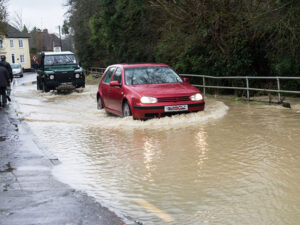
Rain nearly every day, well, winter is coming. Are you ready for the potential challenges of driving on the roads?
There are several safety precautions which should be observed when driving in the rain. These are things you can do to ensure you, your passenger’s, and other people’s safety.
Use your headlights and your wipers.
Not only will using these help you to see better but having your headlights on will make you more visible to other drivers.
Drive more slowly than usual in the rain.
No matter what the speed limit sign says, slow down until you are comfortable. This will also keep you from hydroplaning on standing water you may come across.
Leave lots of braking room between you and the car in front of you.
Do you leave extra room for braking, even if it is not raining that hard? When we were first learning to drive, we were always aware of the “one car length” rule. As we get more confident, we often let this lapse. During rain, it is recommended to leave extra space.
Do not slam on your brakes.
Be honest- do you slow down much while driving in the rain? You need to change your driving style because slamming on your brakes in the wet is another way to skid across the road or hydroplane. You can lose control of your car in this situation and end up in an accident.
Try and avoid standing water.
Avoidance is the easiest way to prevent aquaplaning. Try and follow the ‘tracks’ of the vehicle ahead of you.
If you do hydroplane, react calmly.
Do not slam on your brakes or yank the wheel. Instead, come off the accelerator and try to carefully yet firmly keep your car headed in the direction it is supposed to go.
Use built-in ventilation options to de-fog your windows.
If you cannot see, pull over to avoid an accident.
Engage your brain.
We often behave subconsciously, especially in areas where we are comfortable. If you are entering dangerous weather, take care to be alert of your surroundings and aware of the choices you make while driving.
Do not use cruise control.
If you accidentally hydroplane, cruise control will make the car go faster. It is best to be in control of as much of the car as you can during rainy weather.
Take extra precautions when merging.
Your visibility will be more limited, so make use of all your mirrors and be sure to check over your shoulder. If someone is in the car with you, they can help look for cars. Clearly signal before you move over.
Check and check AGAIN for motorcyclists.
They are easily hidden by rain spray. Make sure you indicate clearly and wait a couple of seconds before you change lanes.
All this guidance is quite a lot to think about. However, if you do come across a massive body of water on the road, here is a guide to driving safely in flooded areas.
Take care of driving through flooded areas after the rain
 Driving through any depth of water can be dangerous. Even just six inches – or 15cm of water – will reach the bottom of most passenger cars. Above this depth, you can lose control or stall the engine because water can be sucked into the exhaust or washed into the air intake.
Driving through any depth of water can be dangerous. Even just six inches – or 15cm of water – will reach the bottom of most passenger cars. Above this depth, you can lose control or stall the engine because water can be sucked into the exhaust or washed into the air intake.
How can I reduce the risk of stalling?
If you are driving a manual car, press the clutch down slightly at the same time as pressing the accelerator. This will help the car move along slowly and should keep water out of the exhaust pipe. Stay in the same gear throughout the flood. In an automatic car, you can consider keeping your foot on the accelerator while using your lowest gear but control the speed with your footbrake.
What if my car stalls in the floodwater?
Do not attempt to restart the engine as you will risk severe damage. You will need to remove the injectors or plugs to get rid of any water. So the best thing to do is to get out of your vehicle and wade to higher ground, especially if the water is rising. Call us when you are safe on 07464 999 247 – we will send our breakdown recovery provider.
What should I do when I am through a flood?
You will need to make sure your brakes are effective – dry them by applying them gently and taking it easy for a few miles after the flood.
Get a winter check
Before setting off on your journey, it is always a good idea to check your car is ready for winter driving. All my guys follow all the government protocols, including handwashing, gel protocols and maintaining safe distances when dealing with customers to avoid physical contact. We do not cross-contaminate or re-contaminate anyone’s vehicle. All equipment is either disposed of or sanitised between all other bookings.
We want to make it as hassle-free as possible for you this winter, save £15 on a safety check by using the code ‘safe15’ when you book a winter health check with us.
Call us on 01628 788 880.

